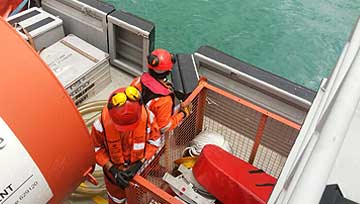
Oil industry delivers containment toolkit to enhance subsea well incident response
- Significant advancement for industry’s subsea well incident intervention capability
- Developed through global industry collaboration
- Designed for use with standard industry well-test hardware to create an innovative containment system
- Now available for international use via Oil Spill Response Limited
Oil Spill Response Limited (OSRL) and the Subsea Well Response Project (SWRP) today announce delivery of a containment toolkit which can be used to minimise the environmental impact of a subsea well incident.
This news builds on the successful delivery of four subsea well capping stacks in 2013-14, designed to shut-in an uncontrolled subsea well.
The containment toolkit is designed to supplement standard industry well test hardware to create an innovative containment system. This toolkit comprises long-lead equipment not readily available in the current industry and minimises response times by allowing a responding well operator to draw on existing resources. In rare scenarios where a well cannot be shut-in, the containment system can be used to flow hydrocarbons from a subsea well to the surface for safe storage and disposal.
During a response, the containment system can be assembled in 1, 2 or up to 3 containment legs depending on the situational need, providing additional response flexibility.
This toolkit is stored in strategic locations to facilitate timely response around the world. Due to their size, the flexible subsea jumpers and subsea flowlines cannot be transported by air, so three sets are stored in the UK, Brazil and Singapore ready for onward transit. All other containment toolkit components are air-freightable and stored with the original equipment manufacturers in the UK, USA and Norway.
Guidelines are also included in this toolkit to assist a well owner/operator in the development of a well-specific containment response plan.
The containment toolkit is now operational and available for industry use through membership of OSRL and a supplementary subscription to OSRL’s Subsea Well Intervention Services (SWIS). SWIS also includes access to capping stack systems to shut in a well and subsea incident response toolkits for debris clearance, site survey, BOP intervention and the subsea application of dispersant at a wellhead.
Robert Limb, Chief Executive Officer at OSRL, said: “SWIS represents OSRL’s ongoing commitment to provide world class responses to an evolving industry. Our expanding portfolio of subsea services helps our members prepare for, and handle, potential subsea well control incidents on a global scale.”
“The introduction of the containment equipment, in addition to the four capping stack systems strategically located worldwide, is an important part of preparation for emergency response to a subsea well incident. While the industry’s commitment to safety means serious subsea incidents are thankfully exceptionally rare, it is vital that the industry regularly re-evaluates and updates its response capabilities with equipment like this.”
Andre Bouquet, Project Manager at SWRP, said: “Delivery of this containment toolkit highlights the continuing benefits of close industry collaboration as we strive to enhance incident response capabilities. We have already worked with OSRL to successfully deliver four capping stack systems and this additional work shows that the industry continues to innovate in the essential field of incident response.”
END
Notes to editors
About the equipment
The containment toolkit is designed to supplement standard industry hardware, such as: vessels, well test equipment, drilling riser, BOP, inner string, coil tubing unit
The toolkit includes: flowline end termination; side-entry flow spool with subsea test tree latch; diverless subsea connectors; coiled tubing termination head; chemical distribution assembly; deployment reels for flying leads; flexible jumpers/flowlines; topside transfer pumps and coolers; hose end valves; offloading hoses
Access to the equipment and guidelines is via membership of OSRL and a supplementary subscription agreement. For more information, interested companies should contact subseaservices@oilspillresponse.com.
Media contact
For more information, contact:
Emma Smille, SWIS Communications and Marketing Lead
+44 23 8033 1551 / EmmaSmillie@oilspillresponse.com
About Oil Spill Response Ltd (OSRL)
(www.oilspillresponse.com / www.swis-oilspillresponse.com)
OSRL is the industry’s leading oil spill response cooperative, providing preparedness, response and intervention services worldwide. Membership represents the majority of global oil production, comprising some 160 environmentally responsible organisations from government, marine and energy-related sectors. Operating from strategic locations in Europe, Africa, the Middle East, Asia Pacific and the Americas, OSRL is the industry leader in this field, having acquired a distinguished track record by attending more than 400 oil spill incidents during the past three decades.
About the Subsea Well Response Project (SWRP)
(www.subseawellresponse.com)
The Subsea Well Response Project (SWRP)’s containment phase involves BP, Chevron, ConocoPhillips, ExxonMobil, Petrobras, Shell, Statoil and Total. The project team consists of technical experts and senior managers from each company. SWRP is operated by an affiliate of Shell, on behalf of the members, with headquarters in Stavanger, Norway. SWRP was launched in May 2011 to enhance international capability to respond to a subsea well-control incident.



